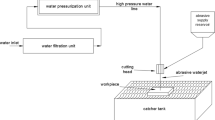Abstract
The abrasive waterjet (AWJ) cutting process has been widely used in the gemstone processing industry due to its versatility and accuracy characteristics. The influence of the parameters involved in the AWJ process has been investigated by many authors, and it can be seen that in each application different responses are reported. In agate processing via AWJ, the final quality of the piece depends on the properties of the initial damage region (IDR), such as width and depth. The present study has purpose to investigate the influence of the standoff distance, traverse speed, working pressure, and abrasive mass flow rate on the depth and width of the IDR when cutting agates through AWJ. A set of 80 samples were analyzed, and the measurement of the depth and width of the IDR was performed through three-dimensional scanning using X-ray computed microtomography (XCM). This technique allows assessing the IDR in an accurate and reliable way. The results showed that, within the investigated range of parameters, the width and depth of the IDR vary between 0.3 and 0.7 mm. Also, the IDR in the agate plates is strongly influenced by the standoff distance.









Similar content being viewed by others
Abbreviations
- Abrasive waterjet:
-
(AWJ)
- Initial damage region:
-
(IDR)
- Depth of initial damage region:
-
(DIDR)
- Width of initial damage region:
-
(WIDR)
- Working pressure of the waterjet:
-
(P)
- X-ray computed microtomography:
-
(XCM)
- Traverse speed:
-
(Vf)
- Abrasive mass flow:
-
(\(\dot {m}_{A}\))
- Standoff distance:
-
(dS)
- Analysis of Variance:
-
(ANOVA)
References
Li H, Wang J (2015) An experimental study of abrasive waterjet machining of Ti-6Al-4V. Int J Adv Manuf Technol 81(1-4):361–369. https://doi.org/10.1007/s00170-015-7245-5
Barp D, Neis PD, Ferreira N (2010) Contribuição ao estudo do processo de corte de ágata por jato dágua em formas complexas. Design e Tecnologia 01
Lima CEA, Lebron R, de Souza AJ, Ferreira NF, Neis PD (2016) Study of influence of traverse speed and abrasive mass flowrate in abrasive water jet machining of gemstones. Int J Adv Manuf Technol 83 (1):77–87. https://doi.org/10.1007/s00170-015-7529-9
Ipar CEAL, Neis PD, Ferreira NF, Heck DJ, Zibetti TF (2020) A new metric for assessing the surface roughness of agate plates cut by abrasive water jet. Int J Adv Manuf Technol 106:4903–4912. https://doi.org/10.1007/s00170-019-04752-5
Kovacevic R (1991) Surface texture in abrasive waterjet cutting. J Manuf Syst 10:32–40
Akkurt A (2010) Cut front geometry characterization in cutting applications of brass with abrasive water jet. J Mater Eng Perform 19(4):599–606. https://doi.org/10.1007/s11665-009-9513-8
Hlavac L (2009) Investigation of the abrasive water jet trajectory curvature inside the kerf. J Mater Process Technol 209:4154–4161. https://doi.org/10.1016/j.jmatprotec.2008.10.009
Hlavac L, Hlavacova I, Gembalova L, Kalicinsky J, Fabian S, Mestanek J, Kmec J, Madr V Experimental method for the investigation of the abrasive water jet cutting quality. J Mater Process Technol 209(20):6190-6195 (2009). https://doi.org/10.1016/j.jmatprotec.2009.04.011. Special Issue: 1st International Conference on Abrasive Processes
Arola D, Ramulu M (1996) A study of kerf characteristics in abrasive waterjet machining of graphite/epoxy composites. J Eng Mater Technol 118-2:256–265. https://doi.org/10.1115/1.2804897
Karakurt I, Aydin G, Aydiner K (2012) An experimental study on the depth of cut of granite in abrasive waterjet cutting. Mater Manuf Process 27(5):538–544. https://doi.org/10.1080/10426914.2011.593231
Çaydas U, Hasçalik A (2008) A study on surface roughness in abrasive waterjet machining process using artificial neural networks and regression analysis method. J Mater Process Technol 202:574–582. https://doi.org/10.1016/j.jmatprotec.2007.10.024
Momber A, Kovacevic R (1998) Principles of abrasive waterjet machining. Springer, Berlin
Arola D, Ramulu M (1997) Material removal in abrasive waterjet machining of metals - surface integrity and texture. Wear 210(1-2):50–58. https://doi.org/10.1016/S0043-1648(97)00087-2
Hloch S, Valicek J (2012) Topographical anomaly on surfaces created by abrasive waterjet. Int J Adv Manuf Technol 59:593–604
Armagan M, Arici AA (2017) Cutting performance of glass-vinyl ester composite by abrasive water jet. Mater Manuf Process 32(15):1715–1722. https://doi.org/10.1080/10426914.2016.1269919
Shahu P, Maity S (2020) Machining performance evaluation of Al 6061 T6 using abrasive water jet process. In: Shunmugam M, Kanthababu M (eds) Advances in Unconventional Machining and Composites, vol 1. Springer Nature Singapore
Gupta V, Pandey P, Garg MP, Khanna R, Batra N (2014) Minimization of kerf taper angle and kerf width using Taguchi’s method in abrasive water jet machining of marble. Procedia Mater Sci 6:140–149
(1999). Gemological Institute of America: Essential Colored Stone - Reference guide, 1st edn
Michelin C (2014) ÁGata do distrito mineiro de Salto do jacuí (Rio Grande do Sul, Brasil): uma caracterização com base em técnicas estratigráficas, petrográficas geoquímicas e isotópicas
DNPM I (2005) Manual técnico de Gemas, 3rd edn
Dana J et al (1997) Dana’s new mineralogy: the system of mineralogy of James Dwight Dana and Edward Salisbury Dana, 8th edn. Wiley, New York
CIENTEC (2009) Características tecnológicas de rochas ornamentais do Estado do Rio Grande do Sul, 1st edn
Montgomery D (2012) Design and analysis of experiments, 8th edn. Wiley, New York. https://books.google.com.br/books?id=XQAcAAAAQBAJ
Chen R, Zhang D, Wu Y (2018) Study on the influence of standoff distance on substrate damage under an abrasive water jet process by molecular dynamics simulation. Friction 6(2):195–207. https://doi.org/10.1007/s40544-017-0168-4
Huang L, Folkes J, Kinnell P, Shipway P (2012) Mechanisms of damage initiation in a titanium alloy subjected to water droplet impact during ultra-high pressure plain waterjet erosion. J Mater Process Technol 212(09):1906–1915. https://doi.org/10.1016/j.jmatprotec.2012.04.013
Author information
Authors and Affiliations
Corresponding author
Additional information
Publisher’s note
Springer Nature remains neutral with regard to jurisdictional claims in published maps and institutional affiliations.
Rights and permissions
About this article
Cite this article
de Abreu e Lima Ipar, C.E., Neis, P.D., Ferreira, N.F. et al. Analysis of the initial damage region in agate plates cut by abrasive waterjet (AWJ) process. Int J Adv Manuf Technol 109, 2629–2638 (2020). https://doi.org/10.1007/s00170-020-05831-8
Received:
Accepted:
Published:
Issue Date:
DOI: https://doi.org/10.1007/s00170-020-05831-8




